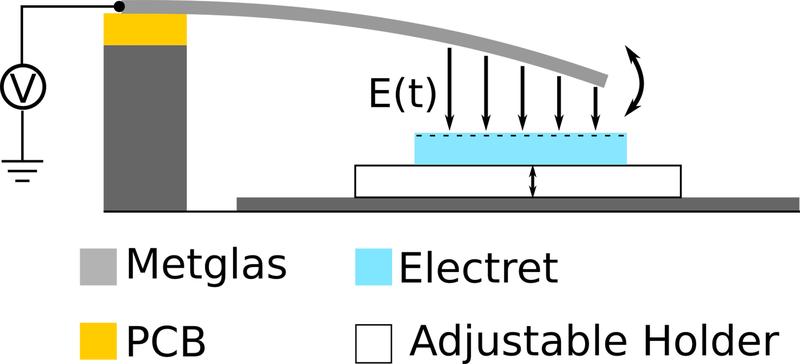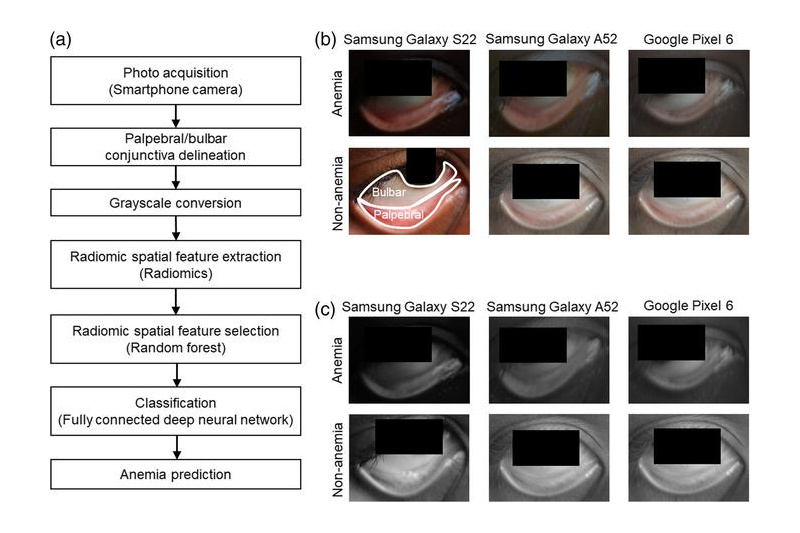

By applying a magnetic field, the bending beam vibrates. A permanently electrically charged electret (blue) pulls the bending beam. This way his vibrance gets stronger.
Copyright: Marleen Schweichel
Electrical signals measurements such as the ECG (electrocardiogram) can show how the human brain or heart works. Next to electrical signals magnetic signals also reveal something about the activity of these organs.
They could be measured with little effort and without skin contact. But the especially weak signals require highly sensitive sensors. Scientists from the Collaboraive research Center 1261 “Magnetoelectric Sensors” at Kiel University have now developed a new concept for cantilever sensors, with the future aim of measuring these low frequencies of heart and brain activity.
The extremely small, energy-efficient sensors are particularly well-suited for medical applications or mobile microelectronics. This is made possible by the use of electrets.
Such material is permanently electrically charged, and is also used in microphones for hearing aids or mobile phones. The research team presented its sensor concept in a special edition of the renowned journal Nano Energy.
Even more effective: converting mechanical energy into electrical energy
The research team led by Professor Rainer Adelung, working group “functional nanomaterials”, and Professor Franz Faupel, working group of multicomponent materials, focuses on cantilever sensors.
These consist of a thin silicon strip, which in the simplest case has two layers applied: the first responds to magnetic fields (magnetostrictive material), and the second can emit an electrical voltage (piezoelectric material).
“If a magnetic field occurs, the first layer deforms and thus bends the whole strip – which vibrates like a diving board at a swimming pool,” explained CRC member Faupel the basic principle. Due to the deformation, the second layer emits a measurable voltage signal.
“With our new sensor concept, we searched for a way to make this conversion of mechanical energy into electrical energy even more effective, by giving the bending beam more impetus,” explained doctoral researcher Marleen Schweichel. The more the bending beam vibrates, the stronger the emitted electrical signal.
Hard material made to vibrate
Normally, so-called soft materials such as plastics vibrate at a low frequency. The vibration is thus significantly damped, and the emitted signal is very weak. With hard materials, significant damping can be avoided. However, a larger mass of material is required for this purpose, which can hardly fit in the small dimensions of the sensor technology.
“With our approach, we were able to make a small bending beam made of hard material behave like a soft material, and vibrate at low frequencies – and what’s more, at an even greater amplitude,” summarised Adelung what is so special about their findings.
Electret materials: permanently electrically charged
The decisive factor was the so-called electret. The research team applied this permanently electrically charged material underneath the bending beam. Normally, the vibrating bending beam pushes back into its original position. However, due to its self-equilibrating stress, the electret pulls the bending beam in the opposite direction, and thereby magnifies the vibration of the beam – and thus the electrical signal of the sensor.
In order to be able to read this signal as accurately as possible, the research team also integrated a new approach towards noise reduction into its alternative sensor concept. With an extremely fast measurement, the individual signals can be “picked up” in between the noise, according to first author Mona Mintken from the working group “functional nanomaterials”.
Sensor with integrated power supply
Thanks to the electrets used in the sensors, it’s not only low frequencies which can be measured better. Similar to permanent magnets, which create their own persistent magnetic field without a power supply, electrets also create their own permanent electric field.
“The electret thereby gives the sensor a built-in electrical potential. The sensor itself then requires no external power supply, and can be used for mobile applications,” explained doctoral researcher Stefan Schröder.
Through a cooperation agreement, he spent three months researching at the Massachusetts Institute of Technology (MIT) in the United States, in order to further improve the required special electret layers. To do so, he used the so-called iCVD (initiator chemical vapour deposition) process, which enables individual material layers to be deposited with high precision.
“The electrets work like a kind of nano-generator, which generates electrical energy. And can do this theoretically for over twenty years,” said materials scientist Faupel. “Sensors with an integrated power supply in such small sizes are also exciting for applications in the area of the 'Internet of Things', which connects decentralised, autonomous electronic systems,” added Adelung.
About the CRC 1261
Magnetic field sensors could make medical diagnosis considerably more comfortable for patients: contactless measurements, without electrodes glued to the skin such as in the case of an ECG, can be carried out faster and for a longer period.
Non-contact sensors could also be moved around during measurement, and thereby precisely localise changes in the magnetic signal. However, the magnetic signals of the human body are relatively weak, and are easily drowned out by other signal sources such as mobile phones or the earth's magnetic field.
In addition to concepts for particularly sensitive, small sensors, techniques are also required to read the measurement data, despite the disturbing noise. Scientists from the fields of materials science, physics and electrical engineering, right through to biology and medicine, are tackling this challenge in the Collaborative Research Centre 1261 “Magnetoelectric Sensors: From Composite Materials to Biomagnetic Diagnostics”.
Photos are available to download:
https://www.uni-kiel.de/de/pressemitteilungen/2019/280-sensoren-1.jpg
Caption: Marleen Schweichel and Stefan Schröder have developed a sensor concept for low frequencies, which is self-powered.
Photo/Copyright: Julia Siekmann, Kiel University
https://www.uni-kiel.de/de/pressemitteilungen/2019/280-sensoren-2.png
Caption: By applying a magnetic field, the bending beam vibrates. A permanently electrically charged electret (blue) pulls the bending beam. This way his vibrance gets stronger and also the emitted electrical signal.
© Marleen Schweichel
https://www.uni-kiel.de/de/pressemitteilungen/2019/280-sensoren-3.png
Caption: Due to the integrated electrets, the newly developed sensors are not only able to measure low frequencies around 140 Hz (red line), but also produce a significantly higher amplitude than other sensor concepts.
© Marleen Schweichel
Contact:
Prof. Dr Rainer Adelung
Kiel University
Functional Nanomaterials working group
Tel.: +49 431 880-6116
E-mail: ra@tf.uni-kiel.de
Web: https://www.tf.uni-kiel.de/matwis/fnano/de
Prof. Dr rer. nat. Franz Faupel
Multicomponent Materials working group Tel.: +49 431 880-6225
E-mail: ff@tf.uni-kiel.de Web: http://www.tf.uni-kiel.de/matwis/matv
Julia Siekmann
Science communication
Priority research area Kiel Nano, Surface and Interface Science (KiNSIS)
Kiel University
Tel.: +49 (0)431/880-4855
E-mail: jsiekmann@uv.uni-kiel.de
Web: http://www.kinsis.uni-kiel.de
More information:
http://info.sfb1261.de
Details, which are only a millionth of a millimetre in size: this is what the priority research area “Kiel Nano, Surface and Interface Science – KiNSIS” at Kiel University has been working on. In the nano-cosmos, different laws prevail than in the macroscopic world – those of quantum physics. Through intensive, interdisciplinary cooperation between physics, chemistry, engineering and life sciences, the priority research area aims to understand the systems in this dimension and to implement the findings in an application-oriented manner. Molecular machines, innovative sensors, bionic materials, quantum computers, advanced therapies and much more could be the result. More information at www.kinsis.uni-kiel.de
Kiel University
Press, Communication and Marketing, Dr Boris Pawlowski, Postal address: D-24098 Kiel, Germany, Telephone: +49 431 880-2104, Fax: +49 (0)431 880-1355
E-mail: presse@uv.uni-kiel.de Internet: www.uni-kiel.de Twitter: www.twitter.com/kieluni Facebook: www.facebook.com/kieluni Instagram: www.instagram.com/kieluni
Prof. Dr Rainer Adelung
Kiel University
Functional Nanomaterials working group
Tel.: +49 431 880-6116
E-mail: ra@tf.uni-kiel.de
Web: https://www.tf.uni-kiel.de/matwis/fnano/de
Prof. Dr rer. nat. Franz Faupel
Multicomponent Materials working group
Tel.: +49 431 880-6225
E-mail: ff@tf.uni-kiel.de
Web: http://www.tf.uni-kiel.de/matwis/matv
Nanogenerator and piezotronic inspired concepts for energy efficient magnetic field sensors, Mona Mintken, Marleen Schweichel, Stefan Schröder, Sören Kaps, Jürgen Carstensen, Yogendra Kumar Mishra, Thomas Strunskus, Franz Faupel, Rainer Adelung, Nano Energy Volume 56, 2019, Pages 420-425
https://doi.org/10.1016/j.nanoen.2018.11.031
https://www.uni-kiel.de/en/details/news/280-sensoren/












